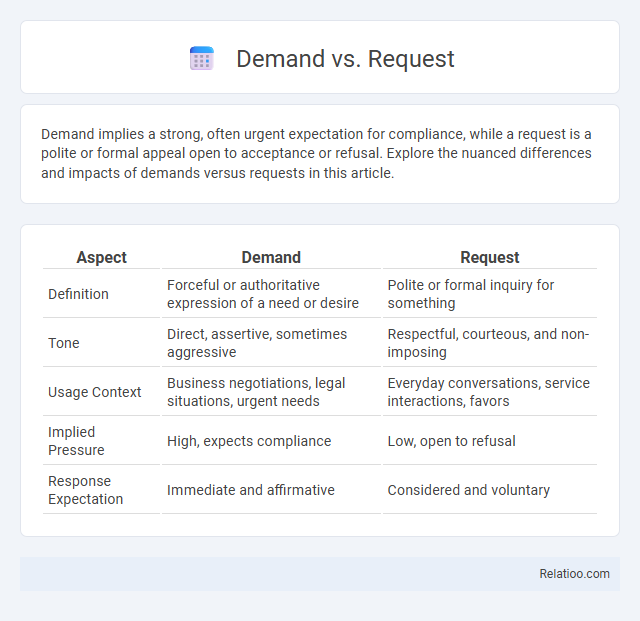Demand implies a strong, often urgent expectation for compliance, while a request is a polite or formal appeal open to acceptance or refusal. Explore the nuanced differences and impacts of demands versus requests in this article.
Table of Comparison
| Aspect | Demand | Request |
|---|---|---|
| Definition | Forceful or authoritative expression of a need or desire | Polite or formal inquiry for something |
| Tone | Direct, assertive, sometimes aggressive | Respectful, courteous, and non-imposing |
| Usage Context | Business negotiations, legal situations, urgent needs | Everyday conversations, service interactions, favors |
| Implied Pressure | High, expects compliance | Low, open to refusal |
| Response Expectation | Immediate and affirmative | Considered and voluntary |
Understanding the Concepts: Demand vs. Request
Demand expresses a firm and non-negotiable need for something, often implying urgency or authority, while a request is a polite or formal appeal made with the expectation of consideration or consent. Understanding the difference between demand and request enables you to communicate more effectively by choosing the appropriate tone based on context. Mastering these concepts improves negotiation skills and fosters clearer interpersonal interactions.
Key Differences Between Demands and Requests
Demands express a firm expectation or requirement, often implying urgency or authority, while requests are polite appeals seeking permission or help, emphasizing courtesy and voluntary compliance. A key difference lies in your ability to refuse: demands typically leave little room for negotiation, whereas requests invite consideration and choice. Understanding these distinctions improves communication effectiveness by aligning your language with the desired response and social context.
The Language of Demanding vs. Requesting
Demanding language is often characterized by direct, authoritative statements that expect compliance without room for negotiation, using imperative verbs and firm tones. Requesting language employs polite, softer phrasing, often incorporating modal verbs like "could," "would," or "may," which express courtesy and openness to refusal. Understanding the distinction between these communication styles is essential in contexts such as business negotiations or customer service, where tone influences response and relationship dynamics.
Psychological Impact: How Demands and Requests Affect Communication
Demands often trigger resistance and defensiveness in communication due to their authoritative nature, causing increased stress and conflict. Requests, framed as collaborative invitations, foster openness and positive engagement by respecting autonomy and encouraging mutual understanding. Understanding these psychological impacts helps improve interpersonal dynamics by promoting more effective and empathetic communication strategies.
Social and Cultural Influences on Demanding and Requesting
Social and cultural influences deeply shape how demand and request are perceived and expressed, affecting the tone and context within which You communicate. In some cultures, making a demand may be seen as assertive or even disrespectful, whereas in others, direct demands demonstrate clarity and strength. Requests often reflect politeness norms and hierarchical relations, with Your choice between demanding and requesting influenced by cultural expectations of formality and social roles.
Practical Examples of Demands and Requests
Demands are firm statements requiring immediate action, such as an employer insisting on a project deadline, while requests are polite expressions seeking permission or help, like asking a colleague for assistance. For example, a manager demanding completion of a report by Friday contrasts with an employee requesting extra time to finish the task. Your understanding of these practical differences helps improve workplace communication by appropriately framing your language in various scenarios.
When to Use a Demand vs. a Request
A demand conveys a strong, non-negotiable insistence often used in legal, business, or authoritative contexts where compliance is expected. A request is a polite or formal appeal seeking permission, assistance, or an action, suitable in everyday communication where cooperation and goodwill are prioritized. Use a demand when urgency and authority outweigh politeness, and a request when maintaining positive relationships and encouraging voluntary action.
Common Misunderstandings: Requests Misinterpreted as Demands
Requests often get misinterpreted as demands due to their similar structures but vastly different tones and intentions. Unlike demands, requests typically leave room for refusal and are polite appeals rather than authoritative commands. This confusion can lead to unnecessary conflict or tension in communication, highlighting the need for clarity in expressing intentions.
Strategies for Turning Demands Into Effective Requests
Turning demands into effective requests involves reframing authoritative or insistent language into collaborative communication that encourages cooperation and understanding. Strategies include using polite language, emphasizing mutual benefits, and clearly articulating the desired outcome to engage the recipient positively. This approach fosters a more receptive response, reduces resistance, and enhances the potential for successful negotiation and problem-solving.
Enhancing Communication: Balancing Demands and Requests
Effective communication requires balancing the assertiveness of demands with the politeness of requests to foster cooperation and respect. Understanding that a demand implies urgency and authority while a request invites voluntary compliance helps you tailor your message for better outcomes. Striking this balance enhances clarity, reduces conflict, and promotes positive interpersonal relationships in both personal and professional settings.

Infographic: Demand vs Request
 relatioo.com
relatioo.com